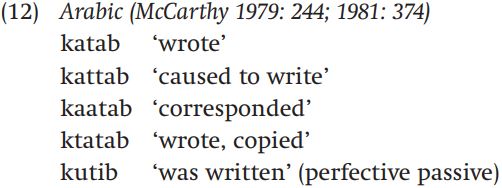


 Grammar
Grammar
 Tenses
Tenses
 Present
Present
 Past
Past
 Future
Future
 Parts Of Speech
Parts Of Speech
 Nouns
Nouns
 Verbs
Verbs
 Adverbs
Adverbs
 Adjectives
Adjectives
 Pronouns
Pronouns
 Pre Position
Pre Position
 Preposition by function
Preposition by function 
 Preposition by construction
Preposition by construction
 Conjunctions
Conjunctions
 Interjections
Interjections
 Grammar Rules
Grammar Rules
 Linguistics
Linguistics
 Semantics
Semantics
 Pragmatics
Pragmatics
 Reading Comprehension
Reading Comprehension|
Read More
Date: 2023-05-22
Date: 20-1-2022
Date: 2023-06-19
|
Templatic morphology
Consider the data in (12):

All of the words in (12) have something to do with writing, and all share the consonants ktb, although in a couple of the forms, there’s more than one t. All the active verb forms have the vowel a; the passive verb form has the vowels ui. Each word has a different pattern of vowels and consonants, and each expresses a slightly different concept. What we find in Arabic is called templatic or root and pattern morphology.
In Arabic, the root of a word typically consists of three consonants (like ktb), the triliteral root, which supply the core meaning. These three consonants may be interspersed with vowels in a number of different ways to modify the meaning of the root. The precise pattern of consonants and vowels – sometimes called the template – can be associated with specific meanings. For example, the pattern CVCVC simply means ‘write’, but the pattern CVCCVC adds a causative meaning, and the pattern CVVCVC a reciprocal meaning (we can take correspond to mean something like ‘write to each other’). Each of these template patterns is called a binyan (a term which comes from traditional Hebrew grammar). The specific vowels that get interspersed between the consonants in these patterns can contribute inflectional meanings; so the vowel a is used in active forms, and the vowels ui in passive forms. Roots in Arabic are occasionally called transfixes because some morphologists look at them as affixes that occur discontinuously across the word.
Root and pattern morphology is very characteristic of the Semitic family of languages, which includes Arabic and Hebrew. But it can also be found in other languages, for example the Uto-Aztecan language Cupeño, a nearly extinct language of Southern California. Cupeño verbs can have a form called the habilitative, which means something like ‘can V’:

One way of looking at the habilitative forms in Cupeño is that they conform to templates like those in (14):

If the only or the second vowel is the stressed vowel, as is the case in the examples in (13a), the habilitative form adds two more syllables, each of which start with [ʔ]. The final vowel of the stem is spread to the new syllables. The situation is slightly different if the first vowel of two is the stressed vowel, as the examples in (13b) show. In that case, the template has only one more syllable than the stem, again with the glottal stop as the consonant, and the vowel supplied by the last stem vowel.
A final example of templatic morphology comes from another Native American language, Sierra Miwok (Penutian family, spoken in California). In this language, new words can be derived by adding a suffix which then supplies a specific template for the base. Consider the examples in (15):

The examples in (15a) show that the suffix -tee-ny, which forms what Smith calls the ‘linear distributive’, makes the verb stem conform to a template of the form CVVCVC. The forms in (15b) have a suffix with the form Ce, where the C is the last consonant of the verb stem. In addition, the verb stem is made to conform to the pattern CVCCVC. Finally, in (15c) verb stems are made into derived forms that mean something like ‘X around’ just by making them conform to a template that looks like CVCVCCVCC, with no suffix added.
|
|
|
|
4 أسباب تجعلك تضيف الزنجبيل إلى طعامك.. تعرف عليها
|
|
|
|
|
|
|
أكبر محطة للطاقة الكهرومائية في بريطانيا تستعد للانطلاق
|
|
|
|
|
|
|
العتبة العباسية المقدسة تبحث مع العتبة الحسينية المقدسة التنسيق المشترك لإقامة حفل تخرج طلبة الجامعات
|
|
|